
The vegetable garden is on a level about five feet below the main backyard level. We can just see the tops of the corn and the trellises from the house. I like this because vegetable gardens don't always look so nice. We built six 4x4 foot bottomless boxes out of large river rocks mortared in place, since that material is what is most readily available and most durable here in the tropics.
During the rainy season we can get 20 inches of rain in 3 or 4 days so a raised bed is really necessary for good drainage. Most vegetables couldn't take being saturated for days at a time. During the dry season, the soil in the boxes get a little hotter than I would like but I have a system of soaker hoses in them so that helps to compensate for the heat. I was lucky enough to find a piece of shade cloth that I use to cover lettuce and other things that just can't take the intense sun.
I grow my vegetables organically using the square foot method in these raised beds. I think the close planting helps to keep the soil cooler but I have to watch out for all kinds of mildew because of the frequent rain and high humidity. I've planted corn as close as four to the square foot, although a friend tells me that is much too dense. I don't know − I get corn! There are no organic products available here, so we make do with compost and manure and use soap or garlic sprays to try to control the insects.
 Originally I filled the boxes almost completely with compost because the orange laterite soil is so poor, but the compost kept decomposing and before long the boxes were only half full. I bought some tierra negra (black soil, or top soil) to add to the beds and that has helped stabilize the soil level, although I don't think it was very good quality soil. I still have to add some compost and/or soil each time I rotate crops. I also add cow or sheep manure when I can get it. I've actually been thinking about getting some chickens (for the eggs and manure) or rabbits (for the manure). I'm basically a city girl, so that would be a big step for me. Also, with three dogs, I will have to figure out a way to protect the chickens from the dogs, and vice versa.
Originally I filled the boxes almost completely with compost because the orange laterite soil is so poor, but the compost kept decomposing and before long the boxes were only half full. I bought some tierra negra (black soil, or top soil) to add to the beds and that has helped stabilize the soil level, although I don't think it was very good quality soil. I still have to add some compost and/or soil each time I rotate crops. I also add cow or sheep manure when I can get it. I've actually been thinking about getting some chickens (for the eggs and manure) or rabbits (for the manure). I'm basically a city girl, so that would be a big step for me. Also, with three dogs, I will have to figure out a way to protect the chickens from the dogs, and vice versa. I like the boxes with a 4 foot width because that is as wide as I can reach into the center of the box without stepping into it and compacting the soil. One thing I will do differently on the next one we build is to make it longer. That will help keep the soil a little cooler because the corners are where the box becomes the hottest. The wide stone rim is about a foot high and is nice for sitting on the side when I'm planting or pulling weeds.
On the lowest level we have our banana plantation. Our handyman/gardener Carlos really wanted to plant bananas down there and
 since I'm still busy with the main parts of the garden, we got the plants for him. The area below is on the edge of a jungle-like creek area and had lots of very tall jungly trees. Several of them fell down during some heavy rainstorms last winter (that made me very sad) so now the area is a part-sun situation which bananas like here. (Okay, the "plantation" is about 10 banana and plantain plants.) ;-)
since I'm still busy with the main parts of the garden, we got the plants for him. The area below is on the edge of a jungle-like creek area and had lots of very tall jungly trees. Several of them fell down during some heavy rainstorms last winter (that made me very sad) so now the area is a part-sun situation which bananas like here. (Okay, the "plantation" is about 10 banana and plantain plants.) ;-) We also have vegetables and fruits growing in the front yard: Moon and Stars watermelon (the first one was 28 pounds!), jicama,
 papayas, a vanilla vine, and some young trees: two avocados, a cinnamon, and a mangosteen. I have some herbs in the raised beds and some in a jardinera (window planter box). We have more papayas, a guayaba, and two types of coconuts in back and malanga (taro) everywhere. Lemon grass is planted in several areas − my dogs love to eat it. The low-growing cilantro which is used for much Honduran cooking is in the shade on the side of the house.
papayas, a vanilla vine, and some young trees: two avocados, a cinnamon, and a mangosteen. I have some herbs in the raised beds and some in a jardinera (window planter box). We have more papayas, a guayaba, and two types of coconuts in back and malanga (taro) everywhere. Lemon grass is planted in several areas − my dogs love to eat it. The low-growing cilantro which is used for much Honduran cooking is in the shade on the side of the house.I've tried direct planting seeds in the garden, planting in cell packs, and presprouting seeds in paper towels. Direct seeding is tough in this climate: either a downpour comes and washes all the seeds into one corner of the bed, the hot tropical sun dries out the seeds before they emerge, or the thousands of giant millipedes devour the seeds or seedlings. Cellpacks are problematic in that potting soil is only rarely available and my compost seems to be too heavy and holds too much water. If the seedlings emerge, the cellpacks have to be moved out into the sun. No matter how many times I rush out into the rain to bring the trays in, there is always one time I forget and find half empty cells with the poor seedlings completely uprooted and broken by the heavy rain.
Now for most seeds, except beans, corn, and very small seeds like lettuce or herbs, I presprout the seeds in damp paper towels. First I write the variety names with a permanent marker on the paper towel, moisten it, and place the seeds below each name. Another damp paper towel is placed on top of the first and the whole thing is folded up and placed in a sealed plastic bag, which is then kept in a warm place. In my case it is on top of a small electric water pump in a closet. The bag needs to be opened and checked each day.
Generally by the second day something has started to sprout and others usually sprout each day until about the eighth or ninth day. My experience with vegetable seeds has been that if they haven't sprouted by the ninth day, they probably aren't going to. As soon as the tiny root begins to show, the seed should be planted in a small pot, cellpack, or in the ground, being sure to water thoroughly so that the root doesn't have a chance to dry out. I usually keep them in pots until the seedling looks strong enough to withstand the rainstorms.
I'm a CPA by profession and a listmaker by nature so in the beginning I kept meticulous records of every seed planted. How, where, when, how many days to germination, to harvest, diagrams of the planting beds, etc., etc. It was partly due to my nature and partly trying to learn more about vegetable gardening in the tropics. I cut back somewhat because it was a little depressing to later write,"one radish, one carrot, two tomatoes!"
My first efforts were pretty pathetic. I've since begun to use a gardening by the moon calendar and have seen remarkable improvements. I don't know if gardening by the moon works or not because there are so many factors that affect growth and germination, but I think I'll keep doing it. It can't hurt! I also like the calendar because it has suggested activities every few days which help to keep me organized.
 While the lack of seasons is great for gardening year round, it is a little too easy to procrastinate when you don't have to worry about that frost deadline. There are no calculations of days to first or last frost here! I can grow pretty much any warm season vegetable year round. Lettuce and things that like cooler temperatures can grow during the rainy season (roughly September to March), or a little longer if I cover them with shade cloth. Another good thing is that compost takes no time at all to finish and there are tons of raw materials available since hardly anyone composts.
While the lack of seasons is great for gardening year round, it is a little too easy to procrastinate when you don't have to worry about that frost deadline. There are no calculations of days to first or last frost here! I can grow pretty much any warm season vegetable year round. Lettuce and things that like cooler temperatures can grow during the rainy season (roughly September to March), or a little longer if I cover them with shade cloth. Another good thing is that compost takes no time at all to finish and there are tons of raw materials available since hardly anyone composts. A bad thing about the lack of seasons is that there is no cold season to kill off or even slow down the bugs. We have cucumber and squash beetles year round. Our average temperature here in La Ceiba is about 86°F and the humidity averages about 86%, too. During the "winter," say December to February, the temperature usually drops a few degrees from that, but it's only gotten below 70°F a few times since I've been here. This is a hoot: Whenever the temperature falls below 80°F, the newspaper reports a frente frio (cold front). I call it a frente tibia. Once the temperature gets down to the low 70's, people will wear winter coats!
I'm feeling my way through all of this. Tropical gardening is so different in many ways, but dealing with the heat in Texas has helped prepare me a little. I have a bookcase full of gardening books but I am most guided by these books:
Texas Organic Vegetable Gardening by J. Howard Garrett
Gardening in the Tropics by Holttum and Enoch
Square Foot Gardening by Mel Bartholomew
The New Seed Starters Handbook by Nancy Bubel
My moon phase calendar is from this site. It's a very informative site for getting a better understanding of moon planting.
Gardening by the Moon
I also belong to several internet gardening groups from which I've learned a lot, but it seems that there aren't many tropical gardeners on these groups. If anyone knows of any groups for tropical gardeners, I'd love to hear from you.





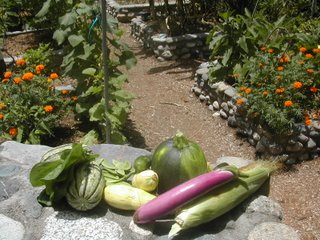

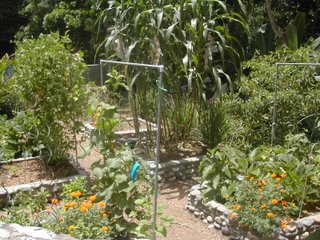
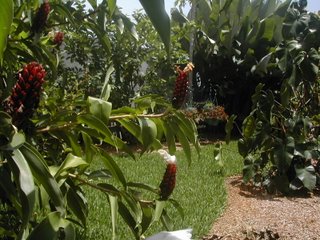

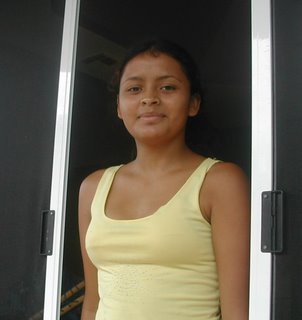


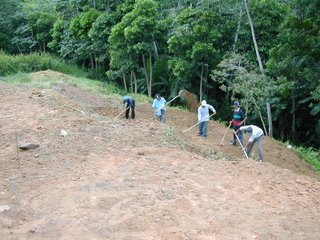



 Welcome to my Blogicito —
Welcome to my Blogicito — 








